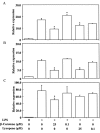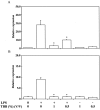Anti-inflammatory Activity of β-Carotene, Lycopene and Tri- n-butylborane, a Scavenger of Reactive Oxygen Species
- PMID: 29475907
- PMCID: PMC5905192
- DOI: 10.21873/invivo.11232
Anti-inflammatory Activity of β-Carotene, Lycopene and Tri- n-butylborane, a Scavenger of Reactive Oxygen Species
Abstract
Background/aim: The polyene carotenoids β-carotene and lycopene are antioxidants that not only quench singlet oxygen but also inhibit lipid peroxidation. Tri-n-butyl borane (TBB) is used as an initiator for dental resin materials and is extremely reactive with oxygen and reactive oxygen species (ROS). This reactionability of TBB may be analogous to that of carotenoids with ROS. To clarify the biological activity of such ROS scavengers, we investigated the anti-inflammatory activity of β-carotene, lycopene and TBB in terms of the expression of RNA for lipopolysaccharide (LPS)-induced cyclooxygenase-2 (Cox2), nitric oxide synthase 2 (Nos2) and tumor necrosis factor-alpha (Tnfa), and mRNA expression and up-regulation of heme oxygenase 1 (Hmox1) mRNA in RAW264.7 cells.
Materials and methods: mRNA expression was investigated using real-time reverse transcriptase-polymerase chain reaction (PCR). The antioxidant activity of carotenoids was evaluated using the induction period method in the azobisisobutyronitrile or benzoyl peroxide-methyl methacrylate system.
Results: Hmox1 mRNA, but not Cox2 and Nos2 mRNA, was up-regulated by 100 μM β-carotene and lycopene, and by 0.125% TBB. LPS-stimulated Cox2, Nos2 and Tnfa gene expression was inhibited by 50 μM β-carotene and lycopene, and by 0.5-1% TBB. Both β-carotene and lycopene had weak antioxidant activity, but β-carotene showed pro-oxidant activity at higher concentrations.
Conclusion: The anti-inflammatory activity of β-carotene, lycopene and TBB may be related to their ROS-scavenging activity. Additionally, the activity of carotenoids and TBB may be attributed to the electrophilicity of ROS-induced carotenoid intermediates and boranes, respectively. Their anti-inflammatory activity may be attributable to enhancement of the potency of the electrophile/antioxidant response element transcription system in view of their up-regulation of Hmox1 mRNA expression.
Keywords: COX2; HMOX1; LPS; NOS2; RAW264.7 cells; lycopene; tri-n-butyl borane; β-Carotene.
Copyright© 2018, International Institute of Anticancer Research (Dr. George J. Delinasios), All rights reserved.
Figures





Similar articles
-
Expression of Cyclooxygenase-2, Nitric Oxide Synthase 2 and Heme Oxygenase-1 mRNA Induced by Bis-Eugenol in RAW264.7 Cells and their Antioxidant Activity Determined Using the Induction Period Method.In Vivo. 2017 Sep-Oct;31(5):819-831. doi: 10.21873/invivo.11135. In Vivo. 2017. PMID: 28882947 Free PMC article.
-
Radical-scavenging and Pro-/anti-inflammatory Activity of Tetracycline and Related Phenolic Compounds With or Without Visible Light Irradiation.In Vivo. 2020 Jan-Feb;34(1):81-94. doi: 10.21873/invivo.11748. In Vivo. 2020. PMID: 31882466 Free PMC article.
-
Cytotoxicity and Pro-/Anti-inflammatory Properties of Cinnamates, Acrylates and Methacrylates Against RAW264.7 Cells.In Vivo. 2018 Nov-Dec;32(6):1309-1322. doi: 10.21873/invivo.11381. In Vivo. 2018. PMID: 30348683 Free PMC article.
-
Protection by beta-carotene and related compounds against oxygen-mediated cytotoxicity and genotoxicity: implications for carcinogenesis and anticarcinogenesis.Free Radic Biol Med. 1992 Oct;13(4):407-33. doi: 10.1016/0891-5849(92)90183-h. Free Radic Biol Med. 1992. PMID: 1398219 Review.
-
Effect of Carotenoids on Paraoxonase-1 Activity and Gene Expression.Nutrients. 2022 Jul 11;14(14):2842. doi: 10.3390/nu14142842. Nutrients. 2022. PMID: 35889799 Free PMC article. Review.
Cited by
-
Recent Progress in Discovering the Role of Carotenoids and Their Metabolites in Prostatic Physiology and Pathology with a Focus on Prostate Cancer-A Review-Part I: Molecular Mechanisms of Carotenoid Action.Antioxidants (Basel). 2021 Apr 10;10(4):585. doi: 10.3390/antiox10040585. Antioxidants (Basel). 2021. PMID: 33920256 Free PMC article. Review.
-
Therapeutic Potential of Leaves from Fridericia chica (Bonpl.) L. G. Lohmann: Botanical Aspects, Phytochemical and Biological, Anti-Inflammatory, Antioxidant and Healing Action.Biomolecules. 2022 Aug 31;12(9):1208. doi: 10.3390/biom12091208. Biomolecules. 2022. PMID: 36139047 Free PMC article. Review.
-
Can Diet Prevent Urological Cancers? An Update on Carotenoids as Chemopreventive Agents.Nutrients. 2022 Mar 25;14(7):1367. doi: 10.3390/nu14071367. Nutrients. 2022. PMID: 35405980 Free PMC article. Review.
-
De novo transcriptome of the diatom Cylindrotheca closterium identifies genes involved in the metabolism of anti-inflammatory compounds.Sci Rep. 2020 Mar 5;10(1):4138. doi: 10.1038/s41598-020-61007-0. Sci Rep. 2020. PMID: 32139778 Free PMC article.
-
Co-treatment of β-carotene with acetamiprid provides protection against acetamiprid induced hepatic and renal toxicity via modulation of the antioxidant system.BMC Pharmacol Toxicol. 2025 Jun 23;26(1):122. doi: 10.1186/s40360-025-00953-9. BMC Pharmacol Toxicol. 2025. PMID: 40551268 Free PMC article.
References
-
- Wang XD, Russell RM. Procarcinogenic and anticarcinogenic effects of β-carotene. Nutr Rev. 1999;57:263–272. - PubMed
-
- Burton GW, Ingold KU. β-Carotene: an unusual type of lipid antioxidant. Science. 1984;224:569–573. - PubMed
-
- Fischer CH, Strassburg M, Knolle G. Tests with a new synthetic filling material over a period of three years (Palakav) Int Dent J. 1970;20:679–689. - PubMed
-
- Nakagawa K, Saita M, Ikeda T, Hirota M, Park W, Lee MC, Ogawa T. Biocompatibility of 4-META/MMA-TBB resin used as a dental luting agent. J Prosthet Dent. 2015;114:114–121. - PubMed
MeSH terms
Substances
LinkOut - more resources
Full Text Sources
Other Literature Sources
Research Materials
